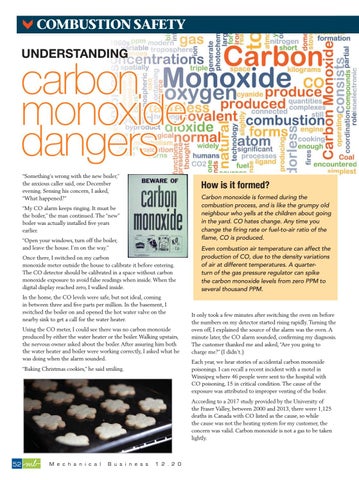COMBUSTION SAFETY UNDERSTANDING
carbon monoxide dangers “Something’s wrong with the new boiler,” bo oiller,” beer the anxious caller said, one December evening. Sensing his concern, I asked, “What happened?”
How is it formed? Carbon monoxide is formed during the combustion process, and is like the grumpy old neighbour who yells at the children about going in the yard. CO hates change. Any time you change the firing rate or fuel-to-air ratio of the flame, CO is produced.
“My CO alarm keeps ringing. It must be the boiler,” the man continued. The “new” boiler was actually installed five years earlier. “Open your windows, turn off the boiler, and leave the house. I’m on the way.” Once there, I switched on my carbon monoxide meter outside the house to calibrate it before entering. The CO detector should be calibrated in a space without carbon monoxide exposure to avoid false readings when inside. When the digital display reached zero, I walked inside. In the home, the CO levels were safe, but not ideal, coming in between three and five parts per million. In the basement, I switched the boiler on and opened the hot water valve on the nearby sink to get a call for the water heater. Using the CO meter, I could see there was no carbon monoxide produced by either the water heater or the boiler. Walking upstairs, the nervous owner asked about the boiler. After assuring him both the water heater and boiler were working correctly, I asked what he was doing when the alarm sounded. “Baking Christmas cookies,” he said smiling.
Even combustion air temperature can affect the production of CO, due to the density variations of air at different temperatures. A quarterturn of the gas pressure regulator can spike the carbon monoxide levels from zero PPM to several thousand PPM.
It only took a few minutes after switching the oven on before the numbers on my detector started rising rapidly. Turning the oven off, I explained the source of the alarm was the oven. A minute later, the CO alarm sounded, confirming my diagnosis. The customer thanked me and asked, “Are you going to charge me?” (I didn’t.) Each year, we hear stories of accidental carbon monoxide poisonings. I can recall a recent incident with a motel in Winnipeg where 46 people were sent to the hospital with CO poisoning, 15 in critical condition. The cause of the exposure was attributed to improper venting of the boiler. According to a 2017 study provided by the University of the Fraser Valley, between 2000 and 2013, there were 1,125 deaths in Canada with CO listed as the cause, so while the cause was not the heating system for my customer, the concern was valid. Carbon monoxide is not a gas to be taken lightly.
52
M e c h a n i c a l
B u s i n e s s
1 2 . 2 0








